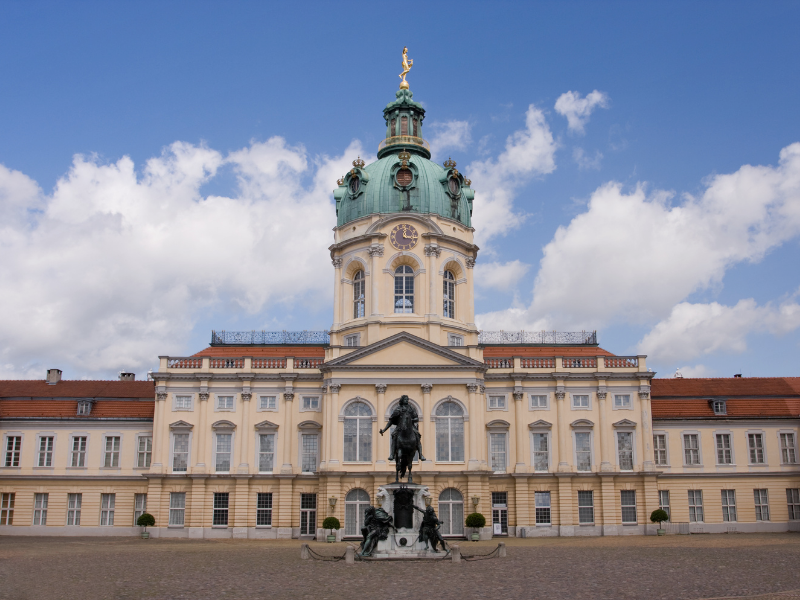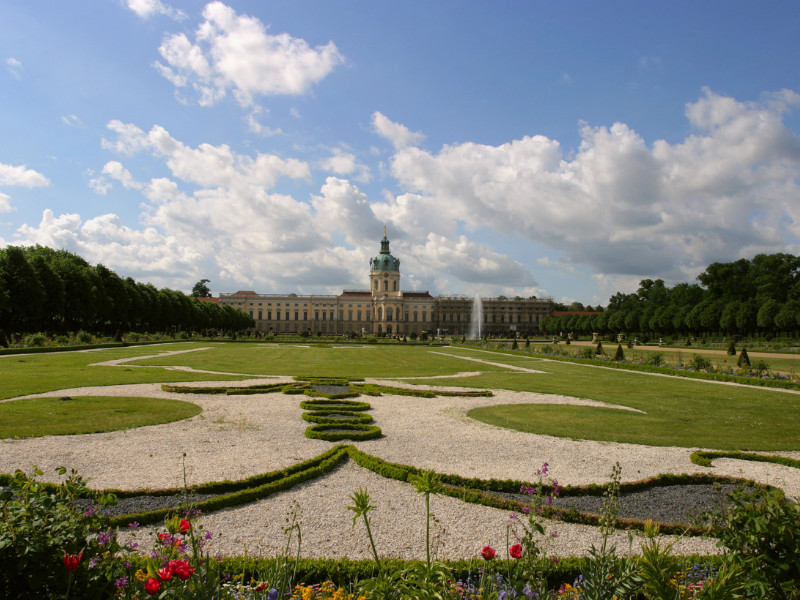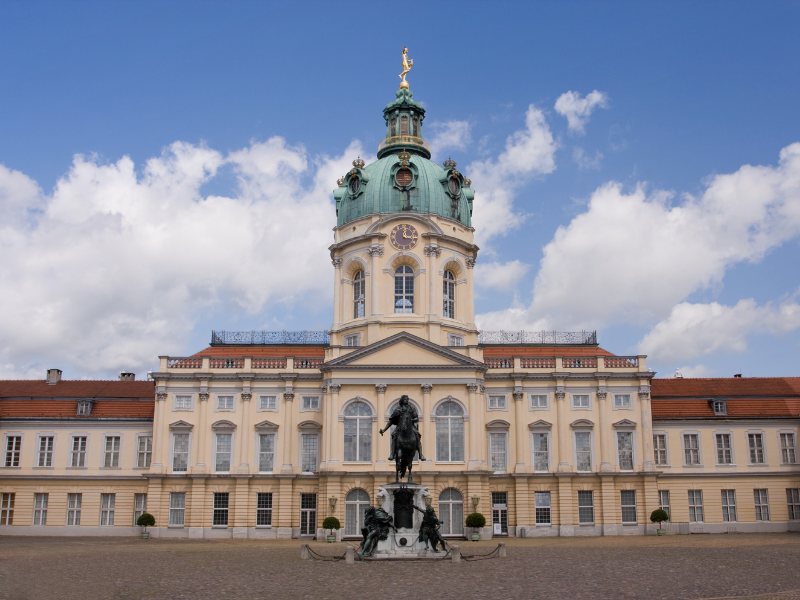Berlin’s biggest palace, Charlottenburg Palace, is a declaration of how grand the Prussian monarchy was. Constructed towards the end of the 17th century and developed further over time, it stands as an astonishing sample of baroque architecture blended with rococo and neoclassical styles.
Historical Context
Origin and Construction
In 1695 Elector Frederick III had Charlottenburg Palace built as a summer retreat for his wife Sophie Charlotte who later became King Frederick I of Prussia. The initial design came from Johann Arnold Nering who kept it rather modest at first but after her death in 1705 it took on many more guises henceforth becoming known as “Charlottenburg”. Over time there were significant enlargements made which turned this place into one of Europe’s most magnificent Baroque palaces.
Royal Residence
Charlottenburg Palace served as the main home for members of the royal family throughout much of the 18th and 19th centuries. This included extensive additions during Frederick I’s reign that reflected power with expensive new wings such like those added by his successors while still underlining wealth through lavish interiors too; all these changes were also made because they wanted people outside Berlin see just how big could be their empire if only they tried harder. Many different types events took place here so it became a very important part not only in life but also among others things culture or courtly living within Prussia during those years.
Historic Events
Many monumental events have taken place in history at Charlottenburg Palace where some even left behind physical reminders. Just to mention two; firstly during Napoleon Bonaparte’s reign over Europe French troops occupied this building complex for quite some time after which it was handed back again but then heavily bombed during World War II so they had to rebuild everything from scratch post-war that’s why today people can still admire such strong structures showing Berlin’s unbreakable spirit as well its royal past.

Design and Architectural Features
Style of Architecture
Charlottenburg Palace is a representation of baroque architecture with its magnificent appearance and intricate details. It has a central main building having symmetrical wings on each side all covered by green dome which makes it very unique among other buildings in Berlin or even Europe where rococo was used instead. The neoclassical additions were later made so as to diversify this place architecturally speaking also.
Plan and Structure
This palace comprises several sections arranged around an inner courtyard which forms the core where one finds the main building together with its dome. There are different wings showing various historical periods as well as different architectural styles inside this structure while the vast garden areas outside provide further beauty thus making it an oasis within city limits.
Gardens and Grounds
Initially, the gardens were designed in French baroque style by Siméon Godeau before being transformed into English landscape gardens during 19th century. These features include fountains, sculptures, geometric patterns among others which are nicely blended with natural vegetation thus creating picturesque environment perfect for relaxation or leisurely walks.
Visiting Charlottenburg Palace
State Apartments
Among the rooms open to public when visiting Charlottenburg Palace are state apartments where luxurious lifestyle monarchs used live their lives could be seen vividly through things like furniture pieces themselves up until tapestries hanging on walls there; these spaces are usually decorated with top quality works arts too. Some most notable include Great Hall that boasts magnificent decorations while White Hall served mainly banqueting purposes but also held ceremonies for royalty too
New Wing (Neuer Flügel)
During the middle of the 18th century, an addition was built; this part known as the New Wing has splendid interiors which were designed by Carl Gotthard Langhans. Among them are such rooms as the Golden Gallery – a luxurious Rococo ballroom and Frederick the Great’s private apartments showing his own taste and style.
Palace Chapel
The Palace Chapel is also worth visiting for its beautifully decorated interior used during royal ceremonies. Its design and decoration are in Baroque style with elaborate stuccoes and gilded ornaments.

The Gardens and Grounds
Baroque Gardens
Siméon Godeau designed the original Baroque gardens of Charlottenburg Palace, which are characterized by their symmetry, ornate fountains, and classical sculptures. These gardens were intended to be awe-inspiring and to demonstrate the power and refinement of the Prussian court.
English Landscape Gardens
During the 19th century, parts of the palace gardens were re-designed in an English landscape style that aimed for a more naturalistic and tranquil setting. This area features curving paths, picturesque ponds, and numerous trees and plants that provide a peaceful refuge from the city’s hustle and bustle.
Belvedere and Mausoleum
Within the palace grounds there is also an interesting variety of structures to explore such as The Belvedere- a charming pavilion housing an 18th-century porcelain collection – as well as The Mausoleum; both adding historical depth and architectural diversity to this beautiful space.
Visiting Charlottenburg Palace
Location and Access
Charlottenburg Palace is situated in Berlin’s Charlottenburg district which can be easily reached via public transport. Here’s how:
- By Metro: The nearest U-Bahn station is Sophie-Charlotte-Platz (U2), only short walk away from the palace.
- By Train: Westend station can be reached by S-Bahn lines S41 or S42 – it takes around 15 minutes on foot to get from there to Charlottenburg Palace.
- By Bus: Several bus lines stopping near the palace include 309 or M45 among others.
Opening Hours & Admission
Different parts of the palace have different opening hours so it is advisable to check out official website beforehand. Usually main palace opens at 10 AM till 6 PM (April-October) or until 5 PM (November-March). Fees for admission vary depending on what areas of both palaces plus gardens you want to visit; there are combo tickets available for those who plan exploring more than one area.
Best Time to Visit
In order to avoid biggest crowds it’s worth considering coming either early morning or late afternoon. Weekdays are generally less crowded than weekends especially outside peak tourist seasons. Gardens look particularly stunning during spring and summer when flowers are blossoming.
Map
Nearby Attractions
Berggruen Museum
Located close to Charlottenburg Palace, Berggruen Museum boasts an impressive collection of modern art including works by Picasso, Klee or Giacometti among others – must see for any art lover as it offers different kind of experience comparing with historical arts found in the palace.
Brohan Museum
Another museum situated nearby is Brohan Museum specializing in Art Nouveau, Art Deco and Functionalism – its rich decorative arts collection furniture ceramics provides interesting insight into these significant design movements.
Kaiser Wilhelm Memorial Church
Short walk from Charlottenburg Palace brings you to Kaiser Wilhelm Memorial Church which serves both as reminder of Berlin’s war-time history but also post-war reconstruction efforts; original church was heavily damaged during World War II so what have been preserved are ruins standing next to new modern one creating symbol peace reconciliation between nations.
Tips for a Memorable Visit
Photography Tips
- Exterior Shots: Take pictures of the palace from various perspectives, especially its main building with iconic dome. Early mornings or late afternoons provide best lighting conditions for outdoor photography.
- Interior Details: While you are inside the palace, please concentrate on the fine points of the furniture, tapestries and art works. Mind about how the rooms are lit and make sure you have a camera that performs well in low light.
- Gardens and Grounds: There are numerous chances to take great pictures in the gardens, starting from symmetrical baroque sections to English landscape areas that are more naturalistic.




